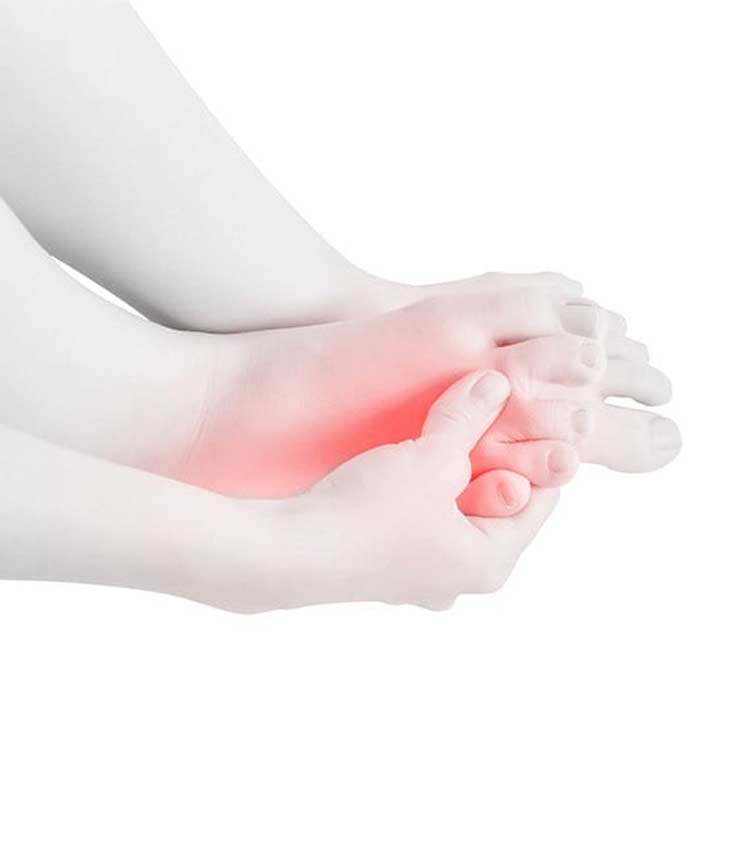
Discover how we can help you find relief from peripheral neuropathy.
About 20 million Americans suffer from peripheral neuropathy, which is damaged or diseased peripheral nerves. These nerves are part of the peripheral nervous system, a communications network that transports sensory information between the brain and spinal cord and other parts of the body. This information could be a signal telling muscles to move or a message, such as letting the brain know the feet are cold. With peripheral neuropathy, sensory information is interrupted or distorted.
- Over 100 types of peripheral neuropathy exist.
- Mononeuropathies are those affecting one nerve, while polyneuropathy are the types involving multiple damaged nerves.
Symptoms
Peripheral neuropathy includes many symptoms. Some of the more common are:
- Pain that is sharp, jabbing, burning, freezing or throbbing
- Numbness that starts gradually and may spread into legs and arms
- Sensitivity to touch
- Lack of coordination
- Prone to falling
- Muscle weakness or paralysis
- Heat intolerance
Symptoms depend on whether damage is to sensory, motor, or autonomic nerves. Neuropathy may affect one, two, or all three. Those with motor nerve damage usually experience muscle weakness, visible muscle twitching and atrophied muscles, as well as cramps and decreased reflexes. Heat intolerance, the inability to sweat normally, loss of bladder control and loss of muscle control are some of the symptoms of autonomic nerve damage.
Because sensory nerves affect many bodily functions, symptoms may include a decrease in sensation. Most often felt in the hands and feet, those affected have reduced reflexes and impaired balance if their eyes are closed. Sufferers may lose the ability to feel pain, notice temperature changes and notice injuries in affected areas. Injuries may become infected, which neuropathy sufferers may also neglect to notice. For diabetes patients, this inability to feel or notice pain contributes to the high number of lower limb amputations.


Causes of Peripheral Neuropathy
Diabetes is the most common cause of peripheral neuropathy among Americans, and over half of those with the disease develop neuropathy. There are many other causes, including kidney disease, liver disease, and inherited disorders, such as Charcot-Marie-Tooth disease. Those with lupus, rheumatoid arthritis and Sjogren’s syndrome may develop peripheral neuropathy. A deficiency in vitamins B or E and niacin are linked to the condition, as is an unhealthy lifestyle related to alcoholism. Some other causes include the following.
- Other autoimmune disease, including Guillian-Barre syndrome, necrotizing vasculitis and chronic inflammatory demyelinating polyneuropathy
- Connective tissue disorders
- Hypothyroidism
- Bone marrow disorders, including lymphoma, amyloidosis, osteosclerotic myeloma and monoclonal gammopathies
- Bacterial or viral infections, including Lyme disease, Epstein-Barr, hepatitis C, shingles and HIV
- Medicines, especially those used in chemotherapy
- Tumors, whether benign or cancerous, may press on nerves or develop on them
Sometimes people develop peripheral neuropathy because of external factors, such as exposure to toxic substances that include chemicals or heavy metals. Falls, sports injuries and other types of trauma can damage or sever peripheral nerves, and casts or crutches can put pressure on the nerves, which could lead to neuropathy. Sometimes the cause of peripheral neuropathy is not known.
Diagnosing Peripheral Neuropathy
Pain, tingling, or weakness in the hands or feet is a signal to check with a doctor about these symptoms. The earlier the diagnosis, the better the chances of preventing further nerve damage. Diagnosing the condition includes a physical exam and possibly a neurological one, which might involve the doctor checking the patient’s reflexes, muscle tone and muscle strength. Posture, coordination and the patient’s ability to feel sensations may also be examined. Sometimes tests are required to make an accurate diagnosis.
- Blood tests to detect diabetes, vitamin deficiencies, abnormal immune function and other conditions
- Imaging tests, such as CT and MRI scans
- Nerve function tests such as electromyography, autonomic reflex screen, sweat tests, and sensory tests
- Nerve or skin biopsies to look for abnormalities or nerve ending reductions
Treatment
Because no cure for peripheral neuropathy is known, treatment is geared toward slowing down disease progression and easing symptoms, such as pain. It includes maintaining foot health for those whose feet are affected. Because peripheral neuropathy causes decreased sensations, patients may not notice a problem with their extremities. A podiatrist will teach neuropathy patients how to thoroughly examine their feet for injuries or infection and will teach them proper foot care while at home. The doctor may treat the condition with oral medication, including pain relievers and topical medicine such as capsaicin cream. Patients typically get advice on proper footwear, avoiding walking barefoot and controlling blood sugar levels. Podiatrists recommend neuropathy patients to see their physician for a foot inspection at least one time per year.

